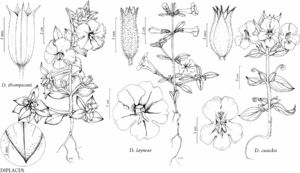Difference between revisions of "Diplacus layneae"
Phytoneuron 2012-39: 29. 2012.
FNA>Volume Importer |
imported>Volume Importer |
||
| (6 intermediate revisions by 2 users not shown) | |||
| Line 10: | Line 10: | ||
|special_status={{Treatment/ID/Special_status | |special_status={{Treatment/ID/Special_status | ||
|code=F | |code=F | ||
| − | |label= | + | |label=Illustrated |
}}{{Treatment/ID/Special_status | }}{{Treatment/ID/Special_status | ||
|code=E | |code=E | ||
|label=Endemic | |label=Endemic | ||
}} | }} | ||
| − | |basionyms={{Treatment/ID/ | + | |basionyms={{Treatment/ID/Basionym |
|name=Eunanus layneae | |name=Eunanus layneae | ||
|authority=Greene | |authority=Greene | ||
| + | |rank=species | ||
| + | |publication_title=Bull. Calif. Acad. Sci. | ||
| + | |publication_place=1: 104. 1885 | ||
}} | }} | ||
|synonyms={{Treatment/ID/Synonym | |synonyms={{Treatment/ID/Synonym | ||
|name=Mimulus brachiatus | |name=Mimulus brachiatus | ||
|authority=Pennell | |authority=Pennell | ||
| − | }}{{Treatment/ID/Synonym | + | |rank=species |
| + | }} {{Treatment/ID/Synonym | ||
|name=M. layneae | |name=M. layneae | ||
|authority=(Greene) Jepson | |authority=(Greene) Jepson | ||
| + | |rank=species | ||
}} | }} | ||
|hierarchy=Phrymaceae;Diplacus;Diplacus layneae | |hierarchy=Phrymaceae;Diplacus;Diplacus layneae | ||
| Line 40: | Line 45: | ||
|elevation=(100–)400–2400 m. | |elevation=(100–)400–2400 m. | ||
|distribution=Calif. | |distribution=Calif. | ||
| − | |discussion=<p>D. M. Thompson (2005) observed that two forms of Diplacus layneae co-occur from the Yosemite National Park area southward; one of these is recognized here as D. graniticola.</p> | + | |discussion=<p>D. M. Thompson (2005) observed that two forms of <i>Diplacus layneae</i> co-occur from the Yosemite National Park area southward; one of these is recognized here as <i>D. graniticola</i>.</p> |
|tables= | |tables= | ||
|references= | |references= | ||
| Line 49: | Line 54: | ||
-->{{#Taxon: | -->{{#Taxon: | ||
name=Diplacus layneae | name=Diplacus layneae | ||
| − | |||
|authority=(Greene) G. L. Nesom | |authority=(Greene) G. L. Nesom | ||
|rank=species | |rank=species | ||
| Line 63: | Line 67: | ||
|publication title=Phytoneuron | |publication title=Phytoneuron | ||
|publication year=2012 | |publication year=2012 | ||
| − | |special status= | + | |special status=Illustrated;Endemic |
| − | |source xml=https:// | + | |source xml=https://bitbucket.org/aafc-mbb/fna-data-curation/src/2e0870ddd59836b60bcf96646a41e87ea5a5943a/coarse_grained_fna_xml/V17/V17_1376.xml |
|genus=Diplacus | |genus=Diplacus | ||
|species=Diplacus layneae | |species=Diplacus layneae | ||
Latest revision as of 19:30, 5 November 2020
Herbs, annual, herbage usually drying dark. Stems erect, 30–160(–300) mm, nodes 3–6, glandular-puberulent to glandular-pubescent, hairs 0.2–0.8 mm. Leaves usually cauline, relatively even-sized; petiole weakly delimited; blade elliptic to narrowly elliptic, oblanceolate, elliptic-oblanceolate, or elliptic-lanceolate, 8–27(–35) × 2–8 mm, margins entire, rarely toothed, plane, apex rounded to obtuse, surfaces: proximals often glabrate, distals glandular-puberulent or glandular-pubescent. Pedicels 2–4(–5) mm in fruit. Flowers 2 per node, or 1 or 2 per node on 1 plant, chasmogamous. Calyces symmetrically attached to pedicels, not inflated in fruit, (5–)6–8(–9) mm, glandular-puberulent to glandular-pubescent, tube strongly plicate, lobes triangular, subequal, apex acute, ribs broad, darkened, blackish, thickened, strongly raised, intercostal areas whitish, membranous. Corollas pinkish or pale to dark magenta or red-purple, each lobe usually with a faint to dark medial line extending 1/2 or less to tip, throat floor yellowish near base, mostly white with red-purple dots near mouth, palate ridges white, tube-throat 10–15 mm, limb (8–)10–16 mm diam., not bilabiate. Anthers included, ciliate. Styles glandular-puberulent. Stigmas included, lobes unequal, abaxial 1.5 times adaxial. Capsules 6–10(–13) mm. 2n = 16.
Phenology: Flowering May–Aug.
Habitat: Road banks, serpentine, granitic sand, red clay, lava beds and volcanic soils, openings in chaparral, shallow dry streambeds or stream banks, burned or otherwise disturbed open areas.
Elevation: (100–)400–2400 m.
Discussion
D. M. Thompson (2005) observed that two forms of Diplacus layneae co-occur from the Yosemite National Park area southward; one of these is recognized here as D. graniticola.
Selected References
None.
